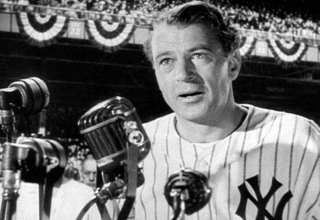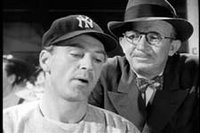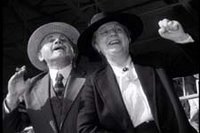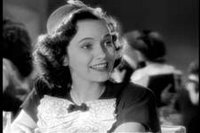 The Pride of the Yankees (1942)
The Pride of the Yankees (1942)
Director: Sam Wood
Lou Gehrig's ashes had barely cooled when this biopic of him hit movie screens across America. The film garnered several Oscar nominations, including one for Best Picture, and is beloved by baseball and film fans alike. I understand why hero-worshipping baseball fans would hug this starry-eyed film to their numbered jerseys. Film fans, though, have no excuse. Although a star-studded cast was assembled, headed by the great Gary Cooper as Gehrig, with a competent, if sentimental, director at the helm, this film is all ham and no bone. What went wrong? First and foremost, we must blame New York sportswriter Paul Gallico, who contributed the story and the treatment. Because of him, we are to believe that a sportswriter, played by Walter Brennan, discovered Gehrig, became his best friend, and was the only person with him when he got the terrible news that he was dying of ALS. Second, we must blame the screenwriters, Herman Mankiewicz and Jo Swerling, for not slam-dunking the treatment in the circular file where it belonged and attempting to bring a little reality to the story of a fine role model who deserved better.
First and foremost, we must blame New York sportswriter Paul Gallico, who contributed the story and the treatment. Because of him, we are to believe that a sportswriter, played by Walter Brennan, discovered Gehrig, became his best friend, and was the only person with him when he got the terrible news that he was dying of ALS. Second, we must blame the screenwriters, Herman Mankiewicz and Jo Swerling, for not slam-dunking the treatment in the circular file where it belonged and attempting to bring a little reality to the story of a fine role model who deserved better.
We also must blame the haste with which this film was conceived and created. It is clear that the Samuel Goldwyn Company wanted to make as much hay out of the widespread grief Americans felt at Lou Gehrig's passing as possible. Making a buck in haste has never done a movie any good.
And what lapses in quality did that haste cause? Well, there was no effort to create a dramatic arc surrounding Gehrig's career. He just hits balls hard and far. Beyond a little rookie baiting at the start of his career with the Yankees, he doesn't seem to know his teammates at all, so the gimmick of casting several real Yankee s, including Gehrig's real best friend, Bill Dickey, was just that--a gimmick. Instead, we are fed generic characters to fill his private life. In addition to the sportswriter, we get Gehrig's quaint German parents (Else Janssen and Ludwig Stössel) who are trotted out when needed for a bit of comic relief and to build the mildest, most nonthreatening tension possible (Mama wants Lou to be an engineer instead of a baseball player; Mama meddles in the home-decorating plans of Lou's new wife).
s, including Gehrig's real best friend, Bill Dickey, was just that--a gimmick. Instead, we are fed generic characters to fill his private life. In addition to the sportswriter, we get Gehrig's quaint German parents (Else Janssen and Ludwig Stössel) who are trotted out when needed for a bit of comic relief and to build the mildest, most nonthreatening tension possible (Mama wants Lou to be an engineer instead of a baseball player; Mama meddles in the home-decorating plans of Lou's new wife).
Cooper's performance is adequate. He has a winning smile and demeanor, and he closely resembled Gehrig, but he mugs horribly when trying to convey the first stages of ALS. Teresa  Wright does her best to bring some sass to Eleanor Twitchell, the woman Lou eventually marries. She does a pretty good job of it, that is, until she becomes Mrs. Gehrig. Then all she gets to do is be deliriously in love and have several playful wrestling scenes with Cooper. Of course, the real Gehrig frequently played hurt and sick to reach his record of 2,130 consecutive games; he broke his hand at least 17 times. It's hard to imagine Lou being able to wrestle with such gusto even before the ALS set in. I can only conclude that the wrestling was meant to serve as action--or maybe it was someone's idea of an ingenious substitute for sex, since we never see Wright and Cooper in bed together at any time during this film.
Wright does her best to bring some sass to Eleanor Twitchell, the woman Lou eventually marries. She does a pretty good job of it, that is, until she becomes Mrs. Gehrig. Then all she gets to do is be deliriously in love and have several playful wrestling scenes with Cooper. Of course, the real Gehrig frequently played hurt and sick to reach his record of 2,130 consecutive games; he broke his hand at least 17 times. It's hard to imagine Lou being able to wrestle with such gusto even before the ALS set in. I can only conclude that the wrestling was meant to serve as action--or maybe it was someone's idea of an ingenious substitute for sex, since we never see Wright and Cooper in bed together at any time during this film.
Someone also thought it would be a good idea to put a completely gratuitous dance number in the movie. So we get a sort of tortured tango in which specialty dancer Veloz does something similar to the headbanger now used in pairs figure skating to his partner Yolanda as the Ray Noble Orchestra plays some hideous Latin music in the background. These performers are featured prominently in the credits. None of them made it to the Golden Age of Musicals. Big surprise.
Finally, I blame Babe Ruth for dancing on the grave of a man he feuded with for the last six of Gehrig's 14 years with the Yankees, not speaking to him until the final tribute in Yankee Stadium. The Babe is featured prominently in a number of scenes, but most obscenely during Gehrig's famous "luckiest man on the face of the earth" speech at the end. We get a medium shot of Cooper as he starts the speech; framed full face in the corner of the screen like one of today's TV station logos is Ruth.
There are so many inaccuracies in this film that it would take another post to list them all. Period costumes, cars, and props are entirely dispensed with. The actors don't age over time either. But the most egregious error, the one that shows the careless way this film was hacked together, is having Cooper portray the left-handed Gehrig as a right-hander in every way but when batting. According to IMDb, this one concession to accuracy was accomplished by flipping the film; Cooper apparently batted right-handed for the camera, too.
All in all, I think there's room for another biopic of Lou Gehrig, now known mostly for the disease which bears his name. I think his reputation as a man and a ballplayer needs to be rescued from the grotesque legacy of The Pride of the Yankees. l


1 Comments:
At 9:28 PM, Anonymous said…
Anonymous said…
Actually, there is indeed another bi-pic of Lou Gehrig, a 1978 telemovie called A Love Affair: The Eleanor and Lou Gehrig Story, with Blythe Danner and Edward Herrmann, directed by Fielder Cook, based on Eleanor Gehrig's book. I saw it, and it was quite good.
Post a Comment
<< Home